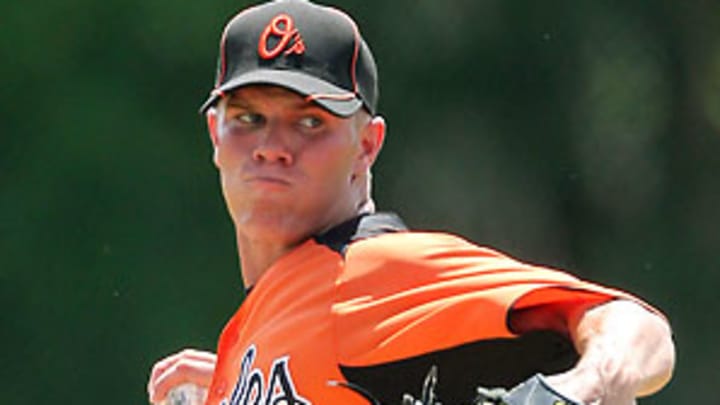Game's top two pitching prospects may be igniting a revolution


Meet Dylan Bundy, the Great Hope of Baltimore and the most fascinating pitching prospect since The Freak, Tim Lincecum.
Bundy is 6-0, 195 pounds, can squat 500 pounds and throw a 100 mph fastball. He's a health and nutrition freak that eats homemade granola bars, drinks broccoli-and-barley smoothies ("Last time he touched a soda pop or hamburger was five years ago," says his father, Denver), swims, boxes, and long-tosses for 30 to 45 minutes at 300 and sometimes even 400 feet, even before starts. He's 19 years old, the best minor league prospect in baseball, and he's about to change how we think about the development of the most valuable currency in the game: the young power arm.
About a year ago, as last year's draft loomed, Dylan Bundy, his father and five officials from the Kansas City Royals were sitting around the Bundy kitchen table at their home, which is on 15 acres "out in the country with the cows," Denver says, in northeast Oklahoma. The Royals, who were picking fifth (the Orioles would draft Bundy a slot earlier), were serious about taking the righthanded phenom who went 11-0 with a 0.20 ERA and 158 strikeouts over 78 innings in his senior year at Owasso High. But they also had deep concerns about Bundy's unconventional pitching program.
"They did not like Dylan throwing long toss," says Denver. "They were discussing the way he throws, how he shouldn't throw on a long arc. Dylan and I were sitting there, just listening. And then, at some point, Dylan just took over. He took over the whole conversation, talking about specific muscle groups, why he does what he does. Before the session was over, he was teaching them about how the shoulder really works. They were in awe."
Long-toss -- a hot-button issue in the major leagues -- is at the heart of Bundy's pitching program. Bundy, as well as Diamondbacks uber-prospect Trevor Bauer, have become the poster-boys for the training method that many think is destroying young arms. Bundy and Bauer disagree. Last year as the draft both players advised certain teams to pass on them because of fears that the organizations would alter their throwing programs. About half the teams in baseball restrict their players to tossing at 120 feet; Bundy and Bauer like to air it out at 200, 300, and, on occasion, 400 feet.
Bauer went third, to the Diamondbacks, and Bundy went one pick later to the Orioles. Now they are the two most dynamic pitchers in the minors. Bundy is putting up mind-boggling numbers: he started the year with a 13-inning hitless streak, and over his first 17 innings has struck out 25, walked two and has yet to allow a run. Opposing hitters are 1-for-50 against him. Bauer is 6-1 with 1.96 ERA and 51 strikeouts in 41 1/3 innings for Class AA Mobile.
Like Bauer, Bundy has an insatiable mind and a tireless work ethic. This spring he was almost always the first player to walk through the doors at the Orioles training facility in Sarasota, Fla., at 6:30 in the morning, and would run for an hour before most of the other players showed up. Orioles strength coach Brady Anderson shadowed Bundy for a few days in Sarasota and signed off on his routine. Bundy has an 80-pound punching bag, which he brought with him from home, set up against his bed in his hotel room. "He's in the room, with the music cranked up, on his knees, still doing his workouts," says Denver.
Much of what Bundy does is about strengthening the range of rotation of his shoulders -- "an emphasis of creating rotation in the shoulder and creating stronger legs," says Denver. "It doesn't do much good to create a greater range of motion in the shoulders, unless at the ends of that range you can add strength. One of the benefits I'm starting to see out of long-toss is that those guys are strengthening, stretching and increasing the range of external rotation of the shoulder by doing long-toss."
Denver adds, "I know that when Dylan pitches he can come back and throw his long toss the next day. One reason is that if anything's wrong, he'll know right away, and something can be done about it. Since we've been doing that, he just never gets sore."
* * *
"It's something I did as a player, it's something I believe in," Rangers pitching coach Mike Maddux says of long-toss. "I remember going to spring training one time [as a player], and went out to play catch, but we were on a regimented catch program. I was kind of shocked. I was saying, 'I'm going to stretch it out, I have to get some long toss in,' and it was, 'No, we're going to play at 60 feet, 90 feet, and bring it back to 60.' And I was like, When are we going to play some long toss? 'Oh, that is our long toss,' they'd say."
Long-tossing vanished from baseball in the 1980s as player salaries increased and pitching injuries mounted. "This 120-[foot] program was built on the medical influence that started in the late 80s and early 90s with Tommy John surgery, and the medical people had more influence on the actual throwing programs," says long-toss guru Alan Jaeger, who has advised several major league teams and tutored the likes of Dan Haren and Barry Zito. "It's what they do in post-rehab surgery to get the arm back in shape, and they do a great job at that -- but that's where the story begins for training, when the rehab is done. Unfortunately the majority of organizations took on this rehab mentality, and all of the sudden you have players training at 120 feet, and it's really been the gospel."
That is, until a few years ago when a handful teams like the Rangers --- a club Jaeger has advised --- reevaluated their pitching programs and began to incorporate long-toss throughout their system. Now Maddux encourages his players at the major league level to air it out -- "long toss is not a number -- everybody's different," he says -- and when new players arrive in Texas, many are dumbfounded. Says Maddux, "Some new guys will line up, and they're saying, Oh my god, we can long-toss it? Yeah, we tell them. Get 'er done, man." Maddux adds, "When you limit players, you lower their ceiling, and you set limits on them."
Jaeger recently compiled a list of the top 11 arms in this year's upcoming draft, and found that all of them have long-tossed out to at least 300 feet and most around 350. He estimates that as recently as four years ago, there were less than five teams open to long-toss. Now he thinks that number is up to 15. Among the recent converts are Bundy's Orioles, whose new director of pitching development, Rick Peterson, is a long-toss advocate. In the Orioles system, Bundy is under no restrictions. In the Diamondbacks system, Bauer is free to throw over 300 feet before games just to loosen up before he starts. He ends up toward the right-field foul pole and launches the ball to a teammate standing near the left-field foul pole. Two throws are required to get the ball back to him.
But there clearly remains a large divide on long-toss, particularly at the major league level, and Bundy and Bauer are leading the revolution to shatter baseball's old-school thinking. "Baseball is one of the most statistical games known to man," says Denver Bundy. "And yet they don't have any statistics on injuries. How many pitchers, for example, were hurt the night after they consumed alcohol, which is a drying agent? We don't know. When it comes to pitching, injuries and developing pitching, they can't tell you anything."
These two phenoms may be about to tell us everything we need to know.
